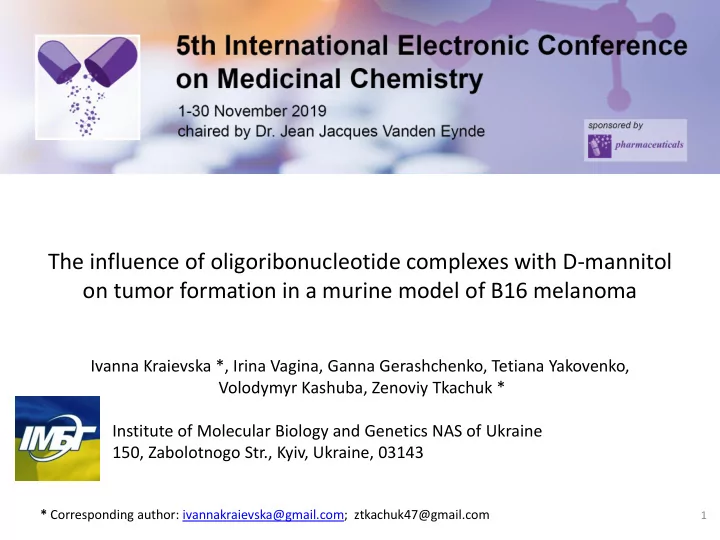

The influence of oligoribonucleotide complexes with D-mannitol on tumor formation in a murine model of B16 melanoma Ivanna Kraievska *, Irina Vagina, Ganna Gerashchenko, Tetiana Yakovenko, Volodymyr Kashuba, Zenoviy Tkachuk * Institute of Molecular Biology and Genetics NAS of Ukraine 150, Zabolotnogo Str., Kyiv, Ukraine, 03143 * Corresponding author: ivannakraievska@gmail.com; ztkachuk47@gmail.com 1
Title of the Presentation ORNs-d-Mannitol complex (ORNs-d-M) is a total yeast RNA with the dominant fraction of 3 – 8 nucleotides, that modified with D- mannitol (D-M). ORNs-d-M promotes the increase of number of T- cells and activates the immune response to cancer cells. 2
Abstract: One of the ways of effective treatment of melanoma is based on strategies to enhance the body's immune response. Oligoribonucleotides- D-mannitol (ORNs-D-M) complexes possess immunotherapeutic actions due to the activation of immune responses. Adult male mice of a C57BL/6J line were injected once by the ORNs-D-M solution at concentrations of 1.4; 0.7; 0.35; 0.175 mg. In the group where animals received 1.4 mg of ORNs-D-M, the formation of the solid tumors was not observed; however, in the group with 0.7 mg dose, the average tumor volume was 97% lower than the non-drug group. Also, the mRNA expression levels of markers of T-cell counts CD3, CD4, CD8, and CD247 approached those of healthy animals. Immunosuppressive state was decreased which reflect in the increased expression of CD274, PDCD1, and IFNB1. Keywords: B16 melanoma; ORNs-D-M; immune response to cancer 3
Introduction At the start of 21st century, melanoma remains a potentially fatal malignancy. At a time when the incidence of many tumor types is decreasing, melanoma incidence continues to increase. Malignant melanoma is considered to be one of the most aggressive forms of skin cancer - about 80% of skin cancer deaths are associated with this disease. Growing tumors can influence on tissue in which they spread, and also communicate with the cells of the immune system of the host. Immunocompromised animals and humans have the high risk of spontaneous occurring tumors. So it reflects the inhibitory role of the immune system on tumor growth. And in fact, immunotherapy has now been clinically validated as an effective treatment for many types of cancer. Recent studies have shown that oligoribonucleotides-D-mannitol (ORNs-D-M) complexes possess exhibit in particular antiviral, anti-inflammatory and immunomodulatory actions due to the activation of immune responses. Given the wide range of biological effects, we aimed to investigate the effect of ORNs- D-M on the development of B16 melanoma in mice.
Results and discussion Our investigations show that different concentrations of ORNs-D-M have the opposite effect on the growth of melanoma B16 tumors. In the group where animals received 1.4 mg of ORNs-D-M, the formation of the solid tumors was not observed; however, in the group with 0.7 mg dose, the average tumor volume was 97% lower than the non-drug group. In the case of lower concentrations, the average tumor size was 2-3 times higher than in the non-drug group. We suggest that such a dose-dependent effect can be explained as follows: ORN contains a fraction of oligoribonucleotides that have an inhibitory effect on tumor development. Only a certain critical concentration of the inhibitor exerts its effect. The dose reduction leads to an increase in tumor size because oligoribonucleotides can be involved in tumor metabolism and the inhibitor concentration is low. A B Fig. 1. The survival of the mice (A) and avarage tumor size (B) when different doses of ORNs-D-M were obtained 5
Results and discussion Also, we observed the changes in the expression of major marker genes. The mRNA expression levels of markers of T-cell counts CD3, CD4, CD8, and CD247, in groups with high concentrations of ORNs-D-M approached those of healthy animals. However, in mice, bearing melanoma recorded a decrease in mRNA levels of these genes. As well ORNs-D-M increases in the immune response to cancer and generally decreases the level of immunosuppression, which reflect in the increased expression of CD274, PDCD1, and IFNB1. Fig. 2. Expression level of T-cell markers (CD3, CD4, CD8, CD247), macrophage markers (CD68, CD163, NOS2), immunotherapy target genes (PDCD1, CD274, CTLA4, CTLA4/del) and cytokine (IFNb1), that were evaluated by real- time qPCR assay in peripheral blood of mice 6
Conclusions • ORN-D-M can effectively inhibit tumor formation in a murine model of B16 melanoma • Genetic analysis shows normalization of the number of T cells and a decrease in the immunosuppressive state of the animal body 7
Recommend
More recommend